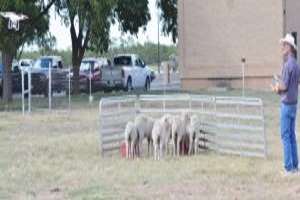By Steve Byrns
They may not replace the pickup, horse or 4-wheeler, much less a good sheep dog, anytime soon, but a Texas A&M AgriLife Research scientist thinks drones have practical ranching applications that will expand in the near future.
Dr. John Walker, resident director of research at San Angelo, said the small unmanned aircraft have gotten pretty popular recently and he wanted to explore their practical application in ranch settings.
“So I went and bought one,” he said. “The first advice someone gave me, and it was good advice, was to buy a cheap one, a toy, and learn to fly it before buying an expensive one.”

Walker said neophytes should plan to spend at least $1,000 or a bit more for a drone, as units in that price range have what is needed for any real practical application.
But what can you do with one other than take aerial photos and video?
“Right now, out of the box, you can use it to check things,” he said. “You can locate lost stock and eventually check fences and waterings. One of the neat things with the more expensive ones is you can program them to run a route, so if you want to check fences, do it once and save that route into the drone. The next time you want to check that fence, you don’t really have to fly it, but just tell it to run that route and it will.
“I’ve used it to herd sheep. It’s fun, but you have to watch where you’re going.
“You can move sheep very gently and that’s really impressed me. I thought as soon as they saw the drone, they’d take off running, but they really don’t. Now goats will a bit at first, but sheep will just move along slow and easy.“
Walker said there are currently plenty of limitations. Battery life is the major one with batteries only lasting about 25 minutes. Obstacles, especially trees and brush, also pose problems, though he said there are models on the market designed to avoid trees and other hazards.
Sun-glare on the screen of a smartphone or iPad used as a monitor on the controller is also a problem, though Walker will soon test the practicality of a pair of “virtual flight” goggles. He said they are worn by the operator for a real-time “drone’s eye view” thus dispensing with the need for the clamped-on screen.
He said the future of using drones on the ranch is bright with a plethora of possibilities.
“I think as the technology improves you’ll be able to do a whole lot of other things,” he said. “What I’m looking forward to is a new type of radio frequency identification ear tag or RFID tag that’s evolving.
“Those in use now only have a range of about 3 feet; basically used with animals going down a working chute. But there are some new ones that can broadcast up to a mile or more. So if your drone was equipped with the appropriate sensor, you could send it up and find those sheep with those particular ear tags and have the drone start drifting the sheep to wherever you wanted them to go.
“I can even imagine having a grazing plan built around this technology where pastures could be divided into different sections and the drone herds the stock into that section and the next day moves them to the next and so on.”
Walker concedes there are some stock-related issues that would have to be worked out, namely a way for making the sheep move once they figured out the drone can’t actually make them. He said a feed reward once they reach their intended destination could well be the answer, much like a cattleman penning cows with a feed sack.
Click here to see more...